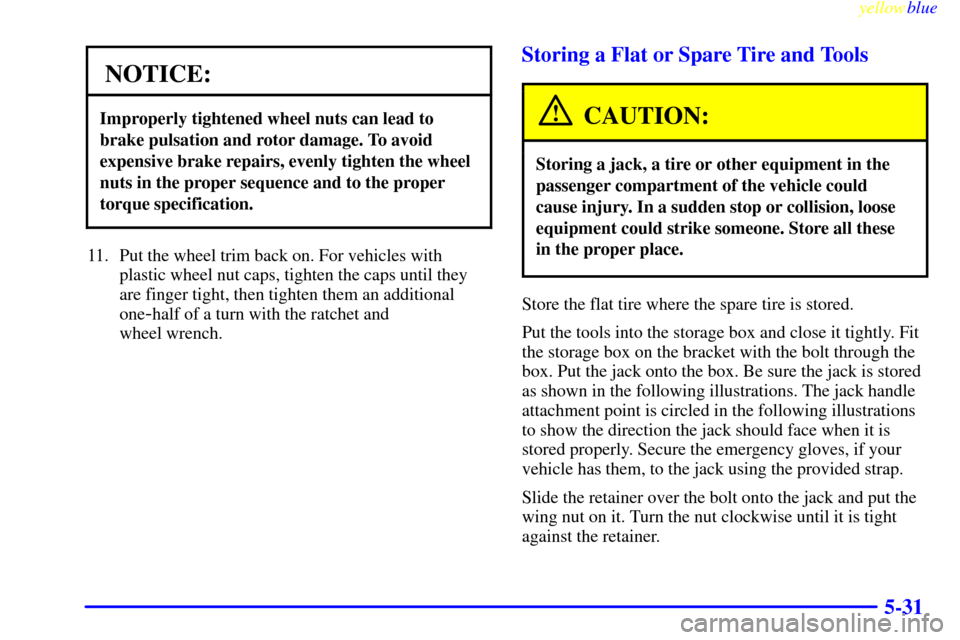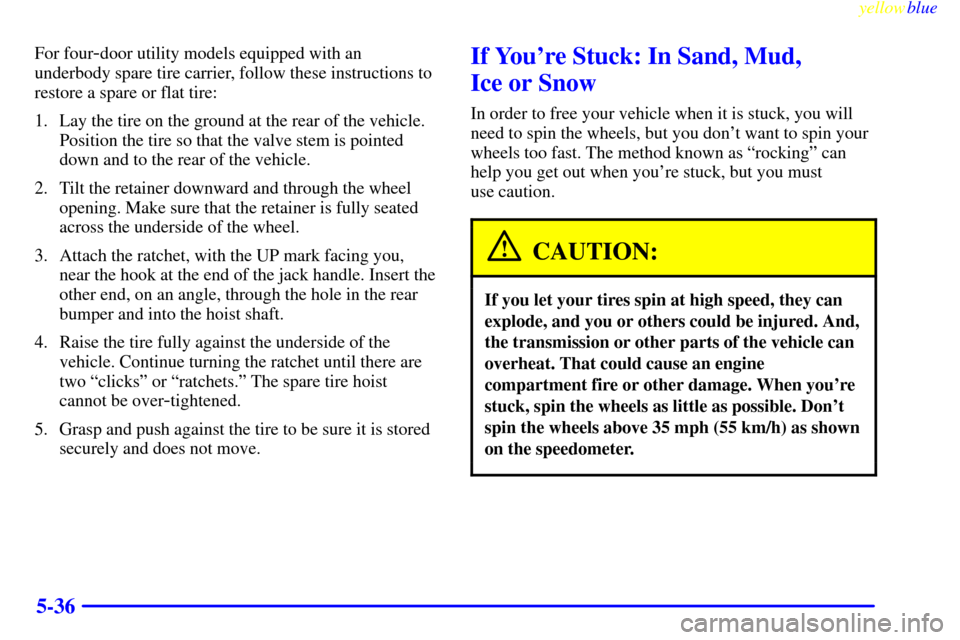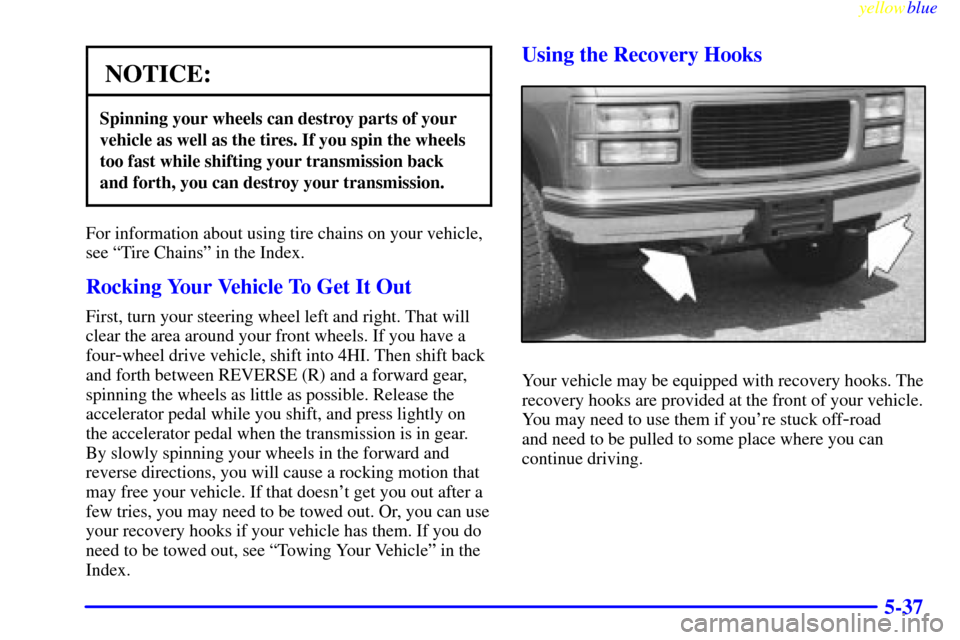Page 273 of 424

yellowblue
5-31
NOTICE:
Improperly tightened wheel nuts can lead to
brake pulsation and rotor damage. To avoid
expensive brake repairs, evenly tighten the wheel
nuts in the proper sequence and to the proper
torque specification.
11. Put the wheel trim back on. For vehicles with
plastic wheel nut caps, tighten the caps until they
are finger tight, then tighten them an additional
one
-half of a turn with the ratchet and
wheel wrench.
Storing a Flat or Spare Tire and Tools
CAUTION:
Storing a jack, a tire or other equipment in the
passenger compartment of the vehicle could
cause injury. In a sudden stop or collision, loose
equipment could strike someone. Store all these
in the proper place.
Store the flat tire where the spare tire is stored.
Put the tools into the storage box and close it tightly. Fit
the storage box on the bracket with the bolt through the
box. Put the jack onto the box. Be sure the jack is stored
as shown in the following illustrations. The jack handle
attachment point is circled in the following illustrations
to show the direction the jack should face when it is
stored properly. Secure the emergency gloves, if your
vehicle has them, to the jack using the provided strap.
Slide the retainer over the bolt onto the jack and put the
wing nut on it. Turn the nut clockwise until it is tight
against the retainer.
Page 274 of 424
yellowblue
5-32
Replace the jack storage cover, if your vehicle has
one, by simply reversing the removal procedure
described earlier.
Jacking Tool Storage
A. Wheel Wrench
B. Jack Handle
C. Ratchet
D. Jacking Tool Storage Box
E. Jack Handle Extension
Jack Storage -- 2-Door Utility Model
A. Retainer
B. Nut
C. Jack
D. Jack Storage Box
E. Bracket
Page 276 of 424
yellowblue
5-34
Store the flat tire in the cargo area of two-door utility
and Suburban models and secure it to the tire carrier. To
store the flat tire:
1. Put the cover back on the tire if your vehicle has one.
2. Put the flat tire in the cargo area of the vehicle, over
the retainer bolt.
3. Slide the adapter onto the bolt in the proper location
for your model and put the wing nut on.
4. Turn the wing nut clockwise until the adapter is tight
and secure against the wheel.
5. Close the tire cover, if you have one.
Spare Tire -- 2-Door Utility Model
1. Carrier
2. J
-Bolt
3. Adapter
4. Spare Tire
5. Nut
6. Cover7. Pins
8. J-Bolt
9. Use Upper Hole and
Pin for P265 Tire or
Lower Hole and Pin
for LT245, P245 and
P235 Tires
Be sure the J
-bolt is hooked properly for your model or
tire size as shown.
Page 278 of 424

yellowblue
5-36
For four-door utility models equipped with an
underbody spare tire carrier, follow these instructions to
restore a spare or flat tire:
1. Lay the tire on the ground at the rear of the vehicle.
Position the tire so that the valve stem is pointed
down and to the rear of the vehicle.
2. Tilt the retainer downward and through the wheel
opening. Make sure that the retainer is fully seated
across the underside of the wheel.
3. Attach the ratchet, with the UP mark facing you,
near the hook at the end of the jack handle. Insert the
other end, on an angle, through the hole in the rear
bumper and into the hoist shaft.
4. Raise the tire fully against the underside of the
vehicle. Continue turning the ratchet until there are
two ªclicksº or ªratchets.º The spare tire hoist
cannot be over
-tightened.
5. Grasp and push against the tire to be sure it is stored
securely and does not move.
If You're Stuck: In Sand, Mud,
Ice or Snow
In order to free your vehicle when it is stuck, you will
need to spin the wheels, but you don't want to spin your
wheels too fast. The method known as ªrockingº can
help you get out when you're stuck, but you must
use caution.
CAUTION:
If you let your tires spin at high speed, they can
explode, and you or others could be injured. And,
the transmission or other parts of the vehicle can
overheat. That could cause an engine
compartment fire or other damage. When you're
stuck, spin the wheels as little as possible. Don't
spin the wheels above 35 mph (55 km/h) as shown
on the speedometer.
Page 279 of 424

yellowblue
5-37
NOTICE:
Spinning your wheels can destroy parts of your
vehicle as well as the tires. If you spin the wheels
too fast while shifting your transmission back
and forth, you can destroy your transmission.
For information about using tire chains on your vehicle,
see ªTire Chainsº in the Index.
Rocking Your Vehicle To Get It Out
First, turn your steering wheel left and right. That will
clear the area around your front wheels. If you have a
four
-wheel drive vehicle, shift into 4HI. Then shift back
and forth between REVERSE (R) and a forward gear,
spinning the wheels as little as possible. Release the
accelerator pedal while you shift, and press lightly on
the accelerator pedal when the transmission is in gear.
By slowly spinning your wheels in the forward and
reverse directions, you will cause a rocking motion that
may free your vehicle. If that doesn't get you out after a
few tries, you may need to be towed out. Or, you can use
your recovery hooks if your vehicle has them. If you do
need to be towed out, see ªTowing Your Vehicleº in the
Index.
Using the Recovery Hooks
Your vehicle may be equipped with recovery hooks. The
recovery hooks are provided at the front of your vehicle.
You may need to use them if you're stuck off
-road
and need to be pulled to some place where you can
continue driving.
Page 281 of 424

6-
yellowblue
6-1
Section 6 Service and Appearance Care
Here you will find information about the care of your vehicle. This section begins with service and fuel information,
and then it shows how to check important fluid and lubricant levels. There is also technical information about your
vehicle, and a part devoted to its appearance care.
6
-2 Service
6
-3 Fuel (Gasoline Engine)
6
-5 Fuels in Foreign Countries (Gasoline Engines)
6
-5 Filling Your Tank (Gasoline Engine)
6
-8 Filling a Portable Fuel Container
6
-8 Checking Things Under the Hood
6
-12 Engine Oil (Gasoline Engine)
6
-16 Engine Air Cleaner/Filter (Gasoline Engines)
6
-19 Automatic Transmission Fluid
6
-22 Rear Axle
6
-22 Four-Wheel Drive
6
-24 Radiator Pressure Cap
6
-25 Thermostat
6
-25 Engine Coolant
6
-28 Power Steering Fluid
6
-29 Windshield Washer Fluid6
-30 Brakes
6
-34 Battery
6
-35 Bulb Replacement
6
-42 Windshield Wiper Blade Replacement
6
-43 Tires
6
-51 Appearance Care
6
-51 Cleaning the Inside of Your Vehicle
6
-54 Care of Safety Belts
6
-55 Cleaning the Outside of Your Vehicle
6
-58 GM Vehicle Care/Appearance Materials
6
-59 Vehicle Identification Number (VIN)
6
-60 Electrical System
6
-65 Replacement Bulbs
6
-67 Capacities and Specifications
6
-68 Air Conditioning Refrigerants
6
-69 Normal Replacement Parts--Gasoline Engines
Page 302 of 424
yellowblue
6-22
Rear Axle
When to Check and Change Lubricant
Refer to the Maintenance Schedule to determine how
often to check the lubricant and when to change it. See
ªScheduled Maintenance Servicesº in the Index.
How to Check Lubricant
If the level is below the bottom of the filler plug hole,
you'll need to add some lubricant. Add enough lubricant
to raise the level to the bottom of the filler plug hole.
What to Use
Refer to the Maintenance Schedule to determine what
kind of lubricant to use. See ªRecommended Fluids and
Lubricantsº in the Index.
Four-Wheel Drive
Most lubricant checks in this section also apply to
four
-wheel-drive vehicles. However, they have two
additional systems that need lubrication.
Transfer Case
When to Check Lubricant
Refer to the Maintenance Schedule to determine how
often to check the lubricant. See ªPeriodic Maintenance
Inspectionsº in the Index.
Page 313 of 424

yellowblue
6-33 Brake Wear
Your vehicle has front disc brakes and rear drum brakes.
Disc brake pads have built
-in wear indicators that
make a high
-pitched warning sound when the brake
pads are worn and new pads are needed. The sound may
come and go or be heard all the time your vehicle is
moving (except when you are pushing on the brake
pedal firmly).
CAUTION:
The brake wear warning sound means that soon
your brakes won't work well. That could lead to
an accident. When you hear the brake wear
warning sound, have your vehicle serviced.
NOTICE:
Continuing to drive with worn-out brake pads
could result in costly brake repair.
Some driving conditions or climates may cause a brake
squeal when the brakes are first applied or lightly
applied. This does not mean something is wrong with
your brakes.
Properly torqued wheel nuts are necessary to help
prevent brake pulsation. When tires are rotated, inspect
brake pads for wear and evenly torque wheel nuts in the
proper sequence to GM specifications.
Your rear drum brakes don't have wear indicators, but if
you ever hear a rear brake rubbing noise, have the rear
brake linings inspected immediately. Also, the rear
brake drums should be removed and inspected each time
the tires are removed for rotation or changing. When
you have the front brake pads replaced, have the rear
brakes inspected, too.
Brake linings should always be replaced as complete
axle sets.
See ªBrake System Inspectionº in Section 7 of this manual
under Part C ªPeriodic Maintenance Inspections.º
Brake Pedal Travel
See your dealer if the brake pedal does not return to
normal height, or if there is a rapid increase in pedal
travel. This could be a sign of brake trouble.